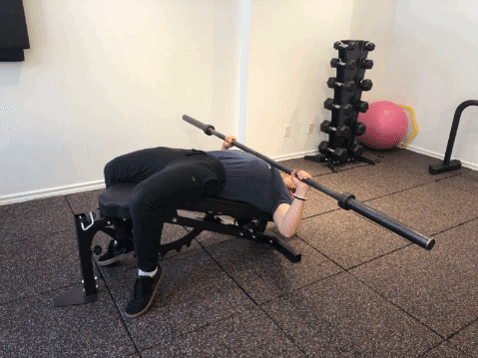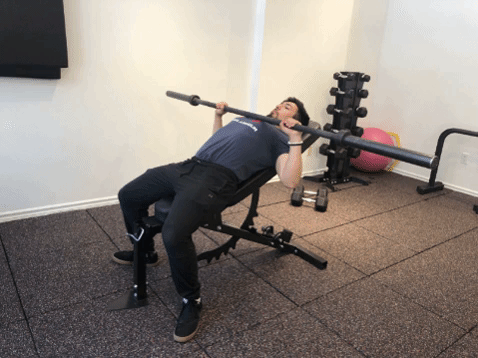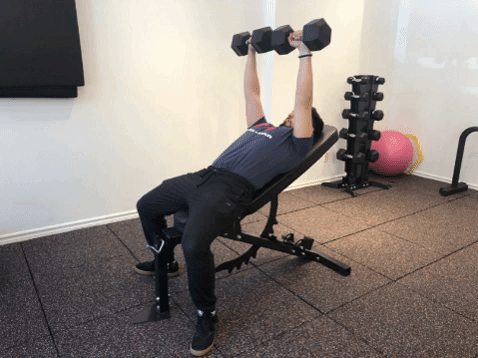The Difference Between Incline Bench Press and Decline Bench Press
Table of Contents
Are You Including Incline and Decline Bench Press Into Your Lower Chest Workout Routine
Whether you’re in the dip training your shoulders by going through a rigorous day of swimming, throwing a ball as far as you can, carrying heavy shopping bags in each arm, or simply pushing a grocery cart down the aisle as you go about your Sunday errands, having properly strong muscles are essential in almost any everyday activity.
Because of this, it’s only common sense that you need to work out your chest muscles just as much as any other muscle group in your body. There’s leg day, and there’s also chest day. Neglecting your chest muscles is the last thing you want to do when you want to work out, and trust us, all that hard work will pay off later, especially as your body starts to slow down with age.
But before you bust open the gym doors and try all of the exercises available, you need to know what exercises will benefit your chest, and how they differ from each other. Of course, you can never go wrong by doing pushups at the comfort of your own home, but crank it up a notch and you’ll get the chest press, which is undoubtedly one of the most effective lower chest workouts you can do. However, you might be met with the choice of picking between the incline or decline chest press on your full body day or lower chest workout day.
Incline or Decline Bench Press - Which Is Better?
Truth is, there really is no wrong or right answer in this one. Both variations and forms exist for a reason, and both will impact your body (and chest) differently. With this, the choice usually comes down to your personal preferences, and what type of goal you have in mind.
But to understand more about their differences, let’s go take a closer look:
What Is a Incline Bench Press
Relative to its name, the incline bench press focuses on the upper part of your chest, mainly the top part of the pectoralis major muscle, which is comprised of both clavicular and sternocostal head, also known as the upper and lower pec. Building the upper portion of the muscle helps give a more fuller look when in the t-shirt and that all around fullness when at the beach.
To do this specific form of workout, you need to first make sure that the bench is set at an incline of around 15 to 30 degrees, which essentially lets you use your shoulders more, what with it mimicking a traditional shoulder press. Furthermore, this exercise also takes away most of the stress you usually get on your rotator cuff, which, for people using the flat bench, is a common place of injury.
Safety Precaution for the Incline Bench Press
Performing an incline bench press allows you to actively use your deltoids at this specific angle, meaning that you may overtrain them. When overtrained, it is advisable that you give it a proper rest day. Overworking it may lead to injury, especially on your lower chest workout day.
How to Do Incline Bench Press
Make sure your bench is adjusted between 15 to 45 degrees on the incline before lying down on it.
Wrap your fingers around the bar firmly and lift it from the rack, making sure that you’re holding it straight over yourself.
Come down slowly while breathing in. Stop when it’s only an inch above your face, and while your arms are on a 45-degree angle.
Hold position, exhale, and push it back up.
Incline Bench Press Muscles Worked
Incline Bench Press Angle
To perform the incline bench press, you need to make sure that the bench is inclined to the correct angle in order to target the correct muscles in the chest. The incline bench press angle should be between 15 and 30 degrees. If the bench is higher than 30 degrees, you will be activating the shoulders more than the chest.
Incline Bench Press Machine
The incline bench press machine is a piece of equipment used to perform a bench press. The incline bench press machine is an alternative to performing the incline bench press on a bench. The machine features two areas where you can load plates, an inclined bench for you to sit on and two handles that you grip to press the machine away from you. The incline bench press machine can be found in many gyms.
Reverse Grip Incline Bench Press
The reverse grip incline bench press is the same movement as the incline bench press, just with an underhand grip. Instead of gripping the bar with your palms facing away from the body, you will grip the bar with the palms facing towards the body. The reverse grip incline bench press can take the pressure off the shoulders and really focus on placing the load on the chest.
Smith Machine Incline Bench Press
The smith machine incline bench press involves placing an incline bench under a smith machine and performing the incline bench press as usual. This variation of the incline bench press provides more stability and control when compared to the barbell incline bench press due to the assistance of the smith machine.
Close Grip Incline Bench Press
A close grip incline bench press involves moving the hands closer together on the barbell to create a close grip. This grip variation will place more stress on the triceps, resulting in increased muscular size and strength in the triceps. The close grip incline bench press can also improve elbow extension and lockout.
Low Incline Bench Press
An incline of zero on the bench would target the mid-chest. When performing the incline bench press, you want the bench to be at a low incline, from 15-30 degrees in order to target the upper chest. Working the upper chest will help to round out your pecs, resulting in a fuller look.
Incline Close Grip Bench Press
If you’d like to target the triceps when performing the incline bench press, try using a close grip. The incline close grip bench press will allow the triceps to be activated more, creating increased muscular size and strength in the muscle. Simply bring your hands closer together on the bar to create a close grip.
Reverse Incline Bench Press
A reverse incline bench press is when you use an underhand grip on the bar. The reverse incline bench press will target the muscles of the chest more than the conventional incline bench press by creating a different stimulus for the pecs.
Wide Grip Incline Bench Press
A wide grip incline bench press is when your grip on the bar is outside of the shoulders. The wide grip incline bench press will involve the chest more throughout the movement when compared to a close grip incline bench press which uses the triceps. Using a wide grip on the incline bench press can also create more stability throughout the movement.
Incline Press Vs Bench Press
The incline press is performed on a bench that is at an incline between 15-30 degrees. The bench press is performed on a flat bench, that does not have an incline. The change in the incline of the bench will alter which area of the chest is receiving the greatest stimulus. For the incline press, the upper pecs will receive the greatest stimulus. For the bench press, the middle of the pec will receive the most stimulus.
What Is a Decline Bench Press
While the incline bench press focuses on the upper part of our chest muscles, the decline bench press dangles your feet up in the air and gets to work on the lower part of your pecs.
Due to its upside down nature, the decline bench press is generally very much underrated as opposed to its incline bench and flat bench counterparts. In fact, it’s often ignored, and trust us, the cobwebs on your gym’s decline bench aren’t leftovers from last Halloween.
Its results are far from being leftovers, as it completes what the incline bench press can’t do on its own. The decline bench press gives you a properly developed chest. In addition to finishing off that lower rounded portion of the pecs that everyone is chasing.
Safety Precaution for the Decline Bench Press
Due to the nature of its position, the decline bench press is generally riskier to do. Make sure you lift with caution or have a spotter when you’re executing this exercise.
How to Do Decline Bench Press
1. Secure both your legs at the bench’s top part and slowly lay down on it.
2. Utilize a medium-width grip, and slowly lift the bar from the rack (you may ask for help from a spotter).
3. With your arms perpendicular to the floor, slowly lift the bar and hold your position.
4. Exhale while you slowly lower it down, holding the position when it goes down on your chest muscles.
5. Hold the position, and inhale as you slowly lift it up again.
6. Repeat until the set is completed.
Variations of Incline and Decline Bench Press
Although both are different variations of the basic flat chest press, both are different in discipline, execution, and of course results. Because the incline bench presses train its focus on the upper fibers of the pectoralis major, it’s mainly suitable for those who want a slim yet controlled and strong chest. Whilst decline bench presses work on your lower pecs and give you a buffer and bigger chest.
Decline Bench Press
Decline Dumbbell Bench Press
Incline Bench Press
Incline Dumbbell Bench Press
Decline Bench Press Vs Flat
The difference between the two is based on the angle chosen on the bench. The decline bench press uses a 30-degree decline. While the flat bench press is parallel to the floor. Decline bench press places greater emphasis on growing the sternal head or lower head of the pectoralis major. In contrast, the flat bench press creates an even activation of both the upper and lower head of the pectoralis major. The reason the activation changes is due to the humerus following the fibre direction of the pectoralis major.
Decline Bench Press Muscles Worked
The decline bench press trains the pectoralis major but has a greater activation of the lower head. While simultaneously strengthening the anterior deltoid and triceps.
The decline bench press will activate the pectoralis major, triceps, and anterior deltoid. Specifically, the decline bench press works the lower head of the pectoralis major.
Decline Close Grip Bench Press
The decline close grip bench press uses a close grip. This means that your hands will be close together on the bar, about one fist or so apart. This grip variation will focus on building strength in the triceps.
Smith Machine Decline Bench Press
The smith machine decline bench press will provide more stability and support in your decline bench press. This can be a good exercise to use if you are just starting out with the decline bench press as need some assistance. Place a declined bench under the smith machine and perform the decline bench press as usual.
Reverse Grip Decline Bench Press
The reverse grip decline bench press involves using an underhand grip instead of the overhand grip. This means that instead of grabbing the bar with your palms facing away from the body, you are grasping the bar with your palms facing towards the body. This variation of the decline bench press will create less involvement of the shoulders and more recruitment of the chest and triceps.
Decline Bench Press Alternatives
There are many alternatives to the decline bench press that you can try. Some decline bench press alternatives can include the decline dumbbell bench press, decline dumbbell fly and high to low cable fly.
The decline bench press has a few exercises that are similar to its movement and will target the same muscles. Some decline bench press alternatives include the using different equipment like a dumbbell to perform the press, a decline dumbbell fly or using a cable machine to perform a high to low fly.
Why Use a Dumbbell Vs a Barbell on Your Lower Chest Workout
When taking into factor whether you should use the dumbbells or barbells you should take a look at how long you have been training for. When performing these exercises it will require a lot of your rotator cuff stabilizers to work. Dumbbells will require a lot more coordination, and shoulder stability.
When first starting it’ll be more recommended that you use the barbell, as well as have a spotter at hand. Eventually when you become more familiar with the exercise and develop those rotator cuff muscles you can dip your foot into the water and grab those dumbbells and take them for a ride.
Which One Is Right for You?
When evaluating what should be right for you, you should look at what you’re not doing, for most it might be the decline press, due to it not being such a common piece of equipment and people’s familiarity with it. For others it might be the incline press, both can be somewhat intimidating but let me assure you that they are easy to perform, especially when taking in my cues and guidance. Feel free to alternate both on your lower chest workout.
Wrapping up What Is Best for Your Lower Chest
Of course, to fully maximize the benefits of these exercises, you can incorporate them both, leading to a strong, muscular, and well-balanced chest. Plus, not only does it help you achieve a fuller chest, but it also helps you add variety to your workouts, which in turn, can help target other parts of your body too.
So don’t be afraid to mix it up a bit, and don’t forget to be safe and have fun!
To read this article in spanish click here!






